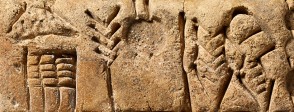The first activity encourages students to observe closely and draw conclusions. It could lead naturally into enquiries into scribes, agriculture in Mesopotamia and the organisation of the city.
Use the photos in For the classroom to explore the tablet. Guide students to observe how it is divided into sections and make an illustrated list of signs and marks indicating those that appear more than once. Identify the symbol showing the ear of barley and where it features on the tablet. Ask them which symbols or marks they think might be numbers for the amounts of barley. Can they work out how the numbers might work? Encourage them to observe very closely and to notice the four types of sign. Once you have established that the tablet indicates quantities, discuss what the other symbols might mean.
Discuss with students how they think the tablet was made. Distinguish which marks were made by inscribing and which by pressing into the clay. Use what they have learned from the preceding activity to help them design their own tablets for different amounts of barley. They could then make their tablets from clay or make replicas of this one. Use the photo of a young visitor to the British Museum in For the classroom.
Who could read and write in ancient Sumer? Consider the purpose of the earliest examples of cuneiform and discuss the differences between who would need to know the information and who would actually need to be able to write it down, recognising that these are not necessarily the same people. You can then move on to the idea of a relatively small number of literate scribes. What would be the advantages and disadvantages of this for the ruler? Explore the work of scribes using the activity in For the classroom.
Show students the photos of the cuneiform tablet in For the classroom which shows a learner’s work. See if they can spot the differences between how the two sides look. Discuss how they have been learning to write and ask them to imagine what the process would have been like for a young Sumern practising to become a scribe.
Explore the history of writing in Iraq using the overview in For the classroom. Create a timeline for the objects and use the British Museum’s website to add more objects.
Look at the examples of writing from other cultures in A bigger picture. Do some map work to locate these cultures and put them on a timeline of writing which students could continue to the present day. Look at the purposes these other examples of writing had. Do some group research on these other types of writing and have a go at copying some of them. You could add these to a display of languages spoken by or known to the students.
Show students examples of modern pictograms such as road signs, warning signs, laundry instruction labels – you will find lots of examples by doing a simple internet search. Discuss the advantages and problems of communicating through pictograms. Ask students why they think Sumern scribes did not draw out animals and plants in detail. Use the link in For the classroom to explore how the sign for barley changed over time.
Try a class experiment with one half of the class using a written recording method and the other half using memory. You might use a variation on Kim’s Game with several examples of a number of things rather than one of each, or some other observation or tally task. The outcome should be pretty conclusive, but you could discuss whether there might be ways of improving the results of the memory team without actually using writing.
What difference does writing make? Ask the students to list all the activities that involve writing in the modern world. Discuss what difference writing makes to these and how they would be affected if writing did not exist. Search the Explore section of the British Museum website for more examples of cuneiform and other ancient scripts and what sorts of thing they were used to communicate. See how these match items on the students’ list of modern uses.


